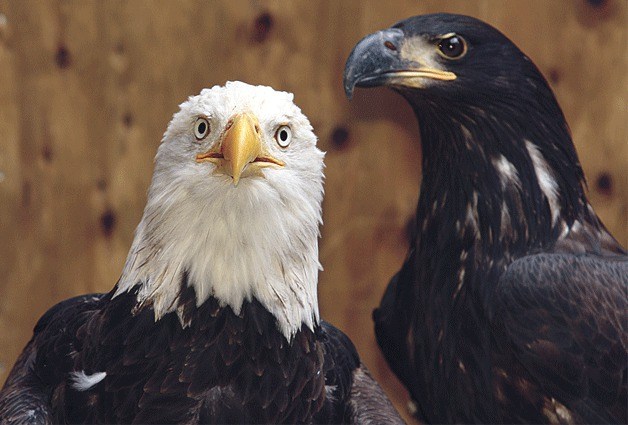At West Sound Wildlife Shelter, we have the privilege of saving the lives of bald eagles each year. Due to their status as our country’s national bird, most people hold eagles in high esteem and experience a thrill when they see them. So I thought it would make sense, in this patriotic month of July, to relate some interesting eagle facts and stories.
One of the bald eagles in our care right now was severely injured in a fight.
A fight with a dog? No. An osprey? No. A coyote?
Nope. It was a fight with another eagle. Eagles are the top of their food chain; other than humans, the only animal eagles have to fear are eagles themselves.
Typically an eagle fight is a fight over territory or a mate or both. Male eagles are, on average, smaller than females so you might say that female eagles rule the skies.
When a fight happens, the two eagles will often lock their talons into each other in what we call a death grip. They’ll then plummet from the sky in a startling mess of feathers, beaks, and talons, finally crashing into the ground where they may maintain their death grip until one of them dies. The “victor” will then do its best to fly away.
The fighting eagle we’re caring for now, a female, was found on the ground in a yard in Brownsville, locked in a death grip with another eagle.
After we physically separated the two eagles, the victor flew away, leaving behind an eagle with deep lacerations on her legs and head and a badly swollen eye. She’s recovering well in our care. Was she protecting her territory and her nest from an intruder? If so, are her chicks doing okay with only their father to care for them? Or was she the intruder, trying to steal territory from another eagle pair? We’ll never know.
In the Puget Sound, eagles begin building or repairing their nests in January and February, mate and lay eggs in March and April, and raise babies in their nests until July and August. Eagles mate for life. As a bonded pair, they will carve out their territory, protect it from other eagles, and return to it for their entire lives. In the wild, an eagle can live 30 years. In captivity, eagles have lived up to 50 years.
They’ll typically raise two eaglets each year in huge stick nests that they build in the tallest suitable tree they can find, often hundreds of feet in the air. Nests have been found that are nine feet in diameter and weigh up to two tons. Sometimes the larger eaglet will kill the smaller eaglet. How’s that for sibling rivalry? Sometimes the nest will collapse or an eaglet will fall (or be pushed) out of the nest. Each year we help save eaglets that find themselves on the ground.
At six weeks of age, the eaglets are nearly the same size as their parents, having added a pound of body weight every four or five days. I’m sure the eaglets never properly thank their parents for working their tails off to bring oodles of food to these little eating machines. A full-grown eagle is usually 30 to 35 inches tall with a wingspan of 75 to 90 inches (6 to 7 feet) and a weight of 10 to 12 pounds.
Ten to 13 weeks after hatching, the eaglets will have grown their flight feathers, which are extra large to make it easier to fly, kind of like training wheels (in total, eagles have 7,000 feathers).
Now it’s time to learn to fly! In some respects, it’s a hilarious process to watch. The eaglets will squawk and screech as they glide, fall and flap through their first flights. “Eaglet coming through. Get out of the way!”
The parents sit back and watch the show, bringing food to grounded eaglets, encouraging them as much as they can, and, I think, laughing at them.
The process, called fledging, is happening around here right now. If you hear an eagle ruckus, there’s probably a juvenile nearby learning how to fly. I encourage you to try to track the bird down and watch. Just stay out of the way and don’t try to interfere, even if the juvenile seems to need some help. If you are concerned, please call us before taking any action; 206-855-9057.
After they have fully fledged and learned how to hunt (typically by the end of summer), the eaglets will be kicked out of the territory and sent out in the world to make their own way.
At 4 and 5 years of age, they will mature sexually, grow their white head feathers, and start the mating, fighting and baby-raising cycle all over again. Hopefully they’ll never need to visit our hospital.



